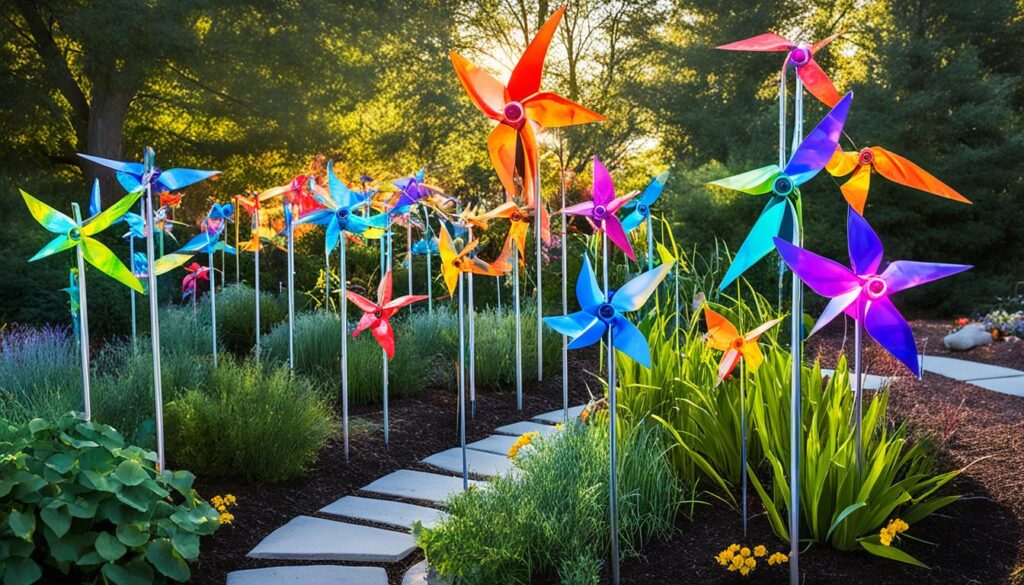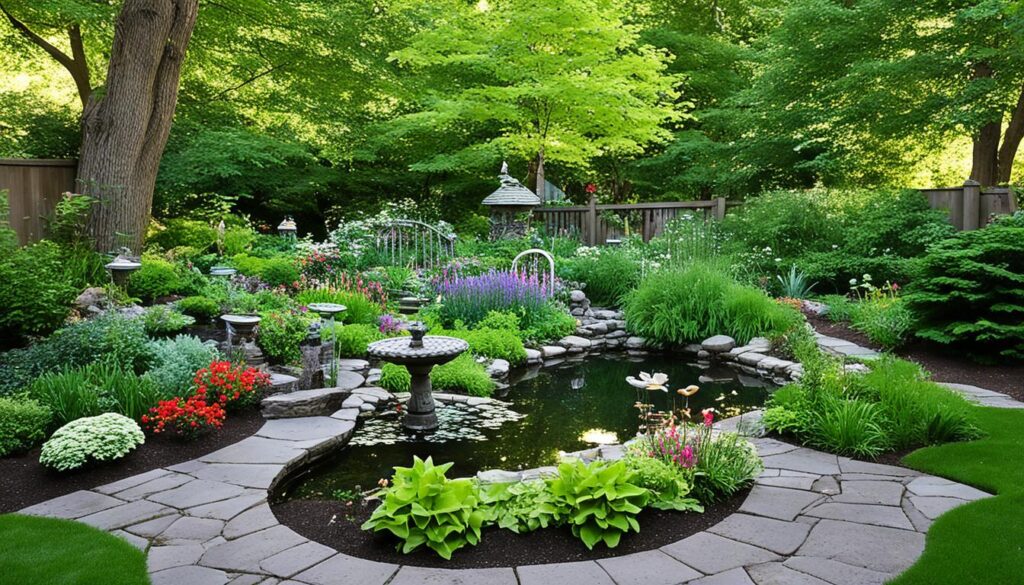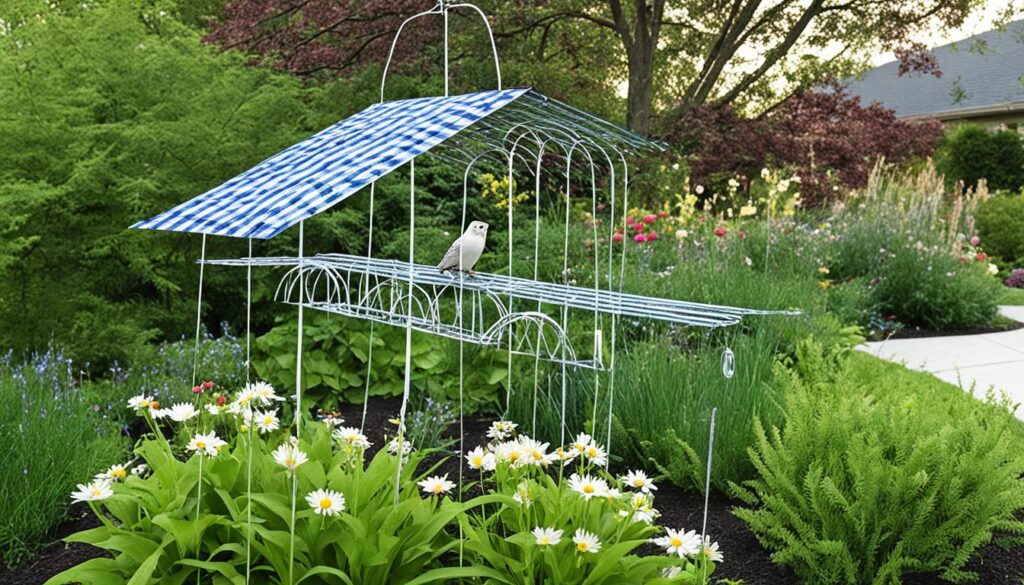Imagine waking up to the relentless and disruptive chirping of a bird just outside your bedroom window. This is the reality for many homeowners, especially those living in areas with abundant avian wildlife. In fact, a recent study found that birds can sing up to 10,000 individual chirps per day, indicating the significant impact their vocalizations can have on our daily lives.
If you’re dealing with a persistent bird that won’t stop chirping outside your home, fear not – there are effective and humane solutions to address this issue. From soundproofing techniques to visual deterrents and environmental modifications, this article will explore a variety of methods to help you reclaim your peace and quiet.
Key Takeaways
- Birds chirp extensively, with up to 10,000 individual calls per day.
- Effective and humane solutions exist to deter birds from chirping near your home.
- Soundproofing, deterrents, and environmental modifications can help reduce bird noise.
- Patience and a combination of methods may be required to successfully stop persistent bird chirping.
- Maintaining a safe and ethical approach is crucial when addressing bird-related issues.
Understanding the Reasons Behind Bird Chirping
Birds are renowned for their melodious chirping, which serves as a means of communication within their species. From establishing territorial boundaries to attracting potential mates, the reasons behind bird chirping are multifaceted and fascinating. Let’s dive into the intricacies of this avian behavior and uncover the insights that explain the dawn chorus and the role of chirping in bird communication.
Why Birds Chirp at Dawn
The dawn chorus, a symphony of birdsong that greets the early morning hours, is a captivating natural phenomenon. Birds, such as sparrows, often chirp at dawn to communicate with one another and mark their territory. This behavior is driven by a combination of physiological and ecological factors. As the day begins, birds are eager to assert their presence, establish dominance, and attract potential mates before the competition intensifies later in the day.
Bird Behavior and Communication Through Chirping
Chirping is a form of vocal communication that serves various purposes in the avian world. Sparrows, for instance, have been observed to have five main reasons for chirping: alarm calls, territorial calls, song/courtship calls, companion/contact calls, and juvenile calls. These distinct vocalizations convey specific information, allowing birds to signal their presence, warn of danger, coordinate with their flock, and engage in mating rituals.
- Alarm calls alert other birds to the presence of predators, such as cats, owls, or weasels.
- Territorial calls are intense bursts of chirping directed at other birds within the same area, often observed during nesting season.
- Song and courtship calls are used to attract potential mates, with house sparrows in urban areas exhibiting a repetitive chirping song for this purpose.
- Companion and contact calls help birds stay in touch with their mated pairs during feeding or movement within their territory.
- Juvenile sparrows beg for food with buzzy calls, accompanied by shaking wings and fluffy plumage.
Chirping is generally a positive and reassuring sound, conveying a sense of contentment and well-being among birds. However, other vocalizations, such as whistling, chiding, squawks, and screeches, can indicate a range of emotions, from happiness to distress and aggression.
“Chirping is the soundtrack of the dawn, a symphony that celebrates the start of a new day and the vibrant life that thrives in the natural world.”
Understanding the reasons behind bird chirping provides valuable insights into their behavior, communication, and the intricate rhythms of the natural world. By appreciating the diverse functions of this avian vocalizations, we can develop a deeper connection with the feathered friends that grace our environments.
Soundproofing Techniques to Reduce Bird Noise
For homeowners dealing with the persistent chirping of pet birds or unwanted visitors, soundproofing techniques can be a game-changer in reducing bird noise and restoring peaceful silence. By blocking bird sounds and minimizing noise transmission, homeowners can create a more tranquil living environment without directly targeting the birds themselves.
Closing Windows and Using Heavy Curtains
One of the most effective soundproofing techniques is to close windows and use heavy curtains. Thick, sound-absorbing curtains can provide an extra layer of noise reduction, muffling the bird sounds from outside. Additionally, the curtains create the illusion of a window within the wall, adding more texture and blocking bird noise more effectively.
“Proper soundproofing benefits both the bird’s comfort and the peaceful relations between neighbors.”
Homeowners can further enhance window treatments for noise reduction by using acrylic or plexiglass enclosures around bird cages, which effectively dampen external sounds. DIY solutions, such as tent-like cage covers or breathable, noise-blocking fabrics, can also help limit noise escape from the bird’s enclosure.

For areas where birds may be nesting near windows, thick sound-reducing curtains or noise-blocking shades can make a significant difference in minimizing the impact of bird chirping. By creating a physical and acoustic barrier, homeowners can enjoy a more peaceful living environment without directly disrupting the birds.
Deterring Birds from Nesting Near Your Home
Maintaining a bird-free environment around your home can be a challenging but necessary task. Birds often choose nesting sites in close proximity to human dwellings, attracted by the available food sources and sheltered areas. However, their persistent chirping and the potential risks associated with bird droppings and nesting materials necessitate proactive measures to deter birds from building nests near your home.
Relocating Bird Feeders and Planting Trees Away
One effective way to discourage birds from nesting near your home is to relocate any existing bird feeders and plant trees or shrubs farther away from the house. By moving the food source and potential nesting sites to a different area, you can draw the birds’ attention and activity away from the immediate vicinity of your home, reducing the likelihood of them choosing to nest in close proximity.
Additionally, planting trees and vegetation away from the main structure of your home can make the area less appealing for birds to nest. Opting for species that are less attractive to common nesting birds, such as certain types of evergreens or dense shrubs, can further deter them from establishing a nest nearby.
https://www.youtube.com/watch?v=BiQXq622XQc
It’s important to note that most bird species are protected by law, making it illegal to kill or remove active nests. Therefore, it’s crucial to take preventive measures before the birds start building their nests, rather than attempting to disrupt an established nest later on.
“Relocating bird feeders and planting trees away from your home can be an effective way to deter birds from nesting nearby, reducing the risk of unwanted chirping and potential health hazards.”
By implementing these simple yet strategic measures, you can create a less inviting environment for birds, encouraging them to nest in areas farther from your home and minimizing the impact of their presence on your daily life.
Using Visual Deterrents to Discourage Birds
Maintaining a peaceful coexistence with birds near your home doesn’t have to be a constant battle. One effective approach is to utilize visual deterrents that can effectively discourage birds from approaching and nesting around your property. By strategically placing window decals and incorporating moving objects, you can create an environment that birds find undesirable, helping to minimize unwanted bird activity.
Window Decals and Moving Objects to Scare Birds
Birds are naturally wary of their own reflections and sudden movements, which you can use to your advantage. Applying window decals featuring predator silhouettes or other visually striking patterns can create the illusion of a threat, causing birds to avoid the area. Similarly, hanging wind chimes, pinwheels, or other moving objects near windows can deter birds from approaching your home.
Reflective surfaces can also be effective in discouraging birds. Mylar streamers, holographic flash tape, and scare-eye diverters are all examples of visual deterrents that can be strategically placed around your property to create an environment that birds find unsettling and unsafe.
“The best way to keep birds away from your home is to make the area as unappealing and uncomfortable for them as possible. Visual deterrents are a simple yet highly effective solution.”
By combining these visual strategies, you can create a multi-layered approach to bird deterrence, making your property less attractive to feathered visitors. Remember to regularly maintain and adjust these visual deterrents to ensure their continued effectiveness in keeping birds at bay.

Masking Bird Sounds with Ambient Noise
If you’re struggling to find peace and quiet due to persistent bird chirping, introducing ambient noise may be a viable solution. By masking the sound of bird vocalizations, you can create a more serene environment around your home. Two effective options to consider are white noise machines and wind chimes.
White Noise Machines
White noise machines emit a consistent, soothing sound that can effectively cover up the chirping of birds. These devices produce a blend of different sound frequencies, creating a calming, neutral backdrop that helps to mask intrusive bird sounds. By running a white noise machine near your outdoor living spaces or open windows, you can drown out the bird chirping and enjoy a more peaceful atmosphere.
Wind Chimes
Another option for masking bird sounds is to install wind chimes around your property. The gentle, melodic sounds produced by wind chimes can help to distract from and cover up the chirping of birds. The continuous, ambient nature of wind chime tones provides a pleasing auditory distraction that can make bird vocalizations less noticeable. Strategically placing wind chimes near areas where you spend time outdoors can create a soothing, bird-muffling effect.
“The gentle, continuous sounds produced by white noise machines and wind chimes can help cover up and distract from bird vocalizations, creating a more peaceful environment.”
By incorporating these ambient noise solutions, you can regain control over the soundscape around your home and enjoy a more tranquil outdoor experience, free from the incessant mask bird sounds, ambient noise to cover chirping, white noise machines, and wind chimes that can disrupt your peace and quiet.
Creating Alternative Habitats for Birds
When dealing with bird chirping near your home, providing alternative habitats can be an effective and bird-friendly solution. By encouraging birds to nest and vocalize in areas away from your residence, you can help minimize the disruption caused by their constant chirping.
One key approach is to plant trees and create nesting areas in locations that are more suitable for the birds. This not only gives them a comfortable place to live but also helps encourage birds to nest elsewhere, away from your home. By establishing these alternative bird habitats, you’re providing a desirable option for the feathered residents, which can significantly reduce the likelihood of them choosing to chirp near your property.
“Creating a welcoming environment for birds in a designated area away from your home can effectively encourage them to relocate and reduce the impact of their chirping.”
When planning your bird-friendly areas, consider factors such as the type of trees, shrubs, and other vegetation that are attractive to the local bird species. Additionally, you can incorporate elements like birdhouses, bird baths, and feeders to make the alternative habitat even more enticing for the feathered visitors.
- Identify suitable locations on your property or in your neighborhood to establish alternative bird habitats.
- Select tree and plant species that are known to provide food, shelter, and nesting opportunities for the birds in your area.
- Incorporate bird-friendly features like birdhouses, feeders, and water sources to make the habitat more attractive.
- Maintain and monitor the alternative habitat to ensure it remains a desirable destination for the birds.
By creating these alternative bird habitats, you can effectively encourage birds to nest elsewhere and reduce the impact of their chirping on your daily life. This approach not only provides a solution to the bird noise but also promotes a more harmonious coexistence between humans and our feathered neighbors.

how to make birds stop chirping
If you’re looking for ways to stop birds from chirping or reduce bird noise around your home, there are several effective techniques you can try. These methods to quiet noisy birds range from soundproofing measures to deterring birds from nesting near your property.
Soundproofing Techniques
One of the most straightforward ways to minimize the impact of bird chirping is through soundproofing. This can involve closing windows and using heavy curtains to block out the noise. Additionally, white noise machines and wind chimes can help mask bird sounds and create a consistent ambient noise that makes the birds less noticeable.
Visual Deterrents
Introducing visual deterrents can be an effective way to discourage birds from nesting near your home. This can include window decals, reflective tapes, or moving objects that scare birds away. Strategically relocating bird feeders and planting trees away from your home can also help reduce the number of birds in your immediate vicinity.
Creating Alternative Habitats
Providing alternative habitats for birds can be a humane and effective solution to reduce bird chirping. This can involve setting up bird houses, bird baths, and native vegetation in areas away from your home, thereby diverting the birds’ attention and reducing their presence near your living space.
By implementing a combination of these techniques to quiet noisy birds, you can create a more peaceful environment and stop birds from chirping without harming the birds themselves. Remember, it’s essential to approach bird management in a humane and ethical manner, respecting the role these animals play in the ecosystem.
“Birds are indicators of the environment. If they are in trouble, we know we’ll soon be in trouble.”
– Roger Tory Peterson, renowned American naturalist and ornithologist
Seeking Neighborhood Cooperation
When dealing with the persistent chirping of birds near your home, seeking cooperation from your neighbors can be a game-changing approach. By working together as a community, you can explore solutions that not only reduce the noise but also ensure the well-being of the local bird population.
Discussing Solutions with Neighbors
One of the first steps to tackling the bird chirping issue is to discuss potential solutions with your neighbors. This collaborative approach allows you to gather diverse perspectives, identify common concerns, and explore a community-wide strategy to address the problem.
When speaking with your neighbors, focus on finding neighborhood cooperation to reduce bird noise. Discuss topics such as:
- Identifying the specific bird species causing the disturbance
- Exploring bird-friendly deterrents that can be implemented across the area
- Coordinating the placement of bird feeders and trees to create alternative habitats
- Agreeing on a consistent approach to soundproofing techniques
By taking acommunity approach to reduce bird noise, you can ensure a more harmonious and effective solution that benefits everyone in the neighborhood.
“Working together with our neighbors to find a peaceful solution to the bird chirping issue has made a significant difference in our quality of life. We’re now able to enjoy the natural sounds of the birds without the constant disruption.”
Remember, the key to successful neighborhood cooperation is open communication, mutual understanding, and a shared commitment to finding a solution that respects both the needs of the residents and the well-being of the local bird population.

Patience and Temporary Solutions
When it comes to dealing with bird chirping, it’s important to approach the situation with patience and understanding. While the constant chirping can be frustrating, it’s crucial to remember that bird behavior can often be temporary and influenced by seasonal changes or natural instincts.
One of the most effective temporary solutions for managing bird chirping is to use masking sounds, such as white noise machines or wind chimes, to help drown out the bird calls. This can provide a short-term respite without directly interfering with the birds’ natural behavior.
Additionally, covering windows or using heavy curtains can help reduce the impact of bird chirping by muffling the sound and preventing the birds from being drawn to the reflections in the glass.
While these temporary measures can be helpful, it’s crucial to manage your expectations and understand that the bird behavior may not change immediately. Patience and a willingness to coexist with the birds are key to finding a harmonious solution.
“The key is to find a balance between addressing the issue and respecting the birds’ natural habitat and behavior.”
By approaching the situation with patience, empathy, and a willingness to explore temporary solutions, you can often find a way to coexist peacefully with the birds and minimize the impact of their chirping on your daily life.
Humane and Ethical Approaches
When it comes to addressing the issue of bird chirping, it’s important to take a humane and ethical approach. After all, birds are a vital part of our ecosystem, and we should strive to coexist with them in a respectful and considerate manner. The key is to find solutions that do not harm the birds or disrupt their natural behaviors.
Dos and Don’ts for Bird-Friendly Solutions
To ensure that your approach to reducing bird chirping is both humane and ethical, consider the following dos and don’ts:
- Do use humane bird deterrents that do not physically harm the birds or damage their nests.
- Don’t use loud sounds or other methods that could frighten or stress the birds.
- Do create alternative habitats for the birds, such as by planting native vegetation that provides them with food and shelter.
- Don’t interfere with the birds’ natural behaviors, such as their mating rituals or nesting patterns.
- Do engage in ethical bird management practices that prioritize the well-being of the birds and the surrounding ecosystem.
- Don’t take actions that could disrupt the local bird population or contribute to environmental degradation.
By following these guidelines, you can effectively address the issue of bird chirping while also ensuring that you’re being a responsible and considerate steward of the natural world.
“The true test of a civilization is how well people treat the animals.”
Remember, the goal is to find ethical bird management solutions that allow you to coexist peacefully with our feathered friends. With a little creativity and a lot of compassion, you can create a backyard that is both bird-friendly and human-friendly.

Safety Considerations When Deterring Birds
When employing methods to deter birds, it’s crucial to prioritize safety. While effectively managing bird-related issues is important, the well-being of the birds and the individuals involved in the process must be the top concern. By understanding the potential risks and taking necessary precautions, you can ensure a safe and humane approach to deterring birds.
One of the key safety considerations when deterring birds is the risk of injury to the birds themselves. Some deterrent methods, if not implemented correctly, can inadvertently harm or distress the birds. It’s essential to research and choose bird deterrent solutions that are safe and humane, minimizing the potential for bird suffering or fatalities.
- Avoid using any deterrents that could physically harm or entrap the birds, such as traps or netting that can cause injury.
- Ensure that visual deterrents, like reflective tapes or moving objects, are installed in a manner that doesn’t obstruct the birds’ flight paths or cause them to collide with surfaces.
- When using sound-based deterrents, consider the volume and frequency to avoid causing distress or disorientation in the birds.
In addition to the safety of the birds, it’s essential to consider the potential risks to human safety when implementing bird deterrent measures. Some activities, such as installing physical barriers or using certain chemicals, may require specialized equipment or precautions to protect the individuals involved.
- Ensure that any physical structures or devices used for bird deterrence are securely installed and do not pose a fall or tripping hazard.
- If using chemicals or other substances to deter birds, follow all safety guidelines and wear appropriate personal protective equipment to avoid exposure or contamination.
- Be mindful of the potential for bird droppings or nesting materials to create slipping or falling hazards, and take necessary steps to maintain a safe work environment.
“Safety should be the top priority when deterring birds, as both the birds and the individuals involved in the process must be protected.”
By prioritizing safety and following appropriate precautions, you can effectively deter birds while minimizing the potential for harm or accidents. Remember, a well-planned and responsible approach to bird deterrence is not only more effective but also the most ethical and responsible course of action.
Engaging Children in Bird-Friendly Activities
Inspiring the next generation to appreciate and protect our feathered friends is a crucial aspect of creating a harmonious coexistence between humans and birds. By engaging children in bird-friendly activities, we can foster a lifelong love for nature and the importance of bird conservation.
One of the most engaging ways to involve children in bird-friendly activities is by creating alternative habitats for birds around your home. This can be as simple as setting up a birdhouse or a birdbath, or as elaborate as planting native flowers and trees that attract various bird species. Children can participate in the design, construction, and maintenance of these habitats, learning valuable lessons about the needs of different bird populations.
- Observe bird behavior and identify different species
- Learn about the importance of bird conservation
- Participate in citizen science projects to monitor bird populations
- Create DIY bird feeders and bird baths
- Plant native flowers and trees to attract birds
These family-friendly bird conservation activities not only provide educational opportunities for children but also cultivate a deeper appreciation for the children’s involvement in bird-friendly activities. By engaging children in these hands-on experiences, we can inspire the next generation to become stewards of our natural world and advocates for the protection of our avian neighbors.
“Children are the future caretakers of our environment, and by instilling a love for birds and their habitats, we can help shape a more sustainable and harmonious future.”

Nurturing a child’s curiosity and connection with the natural world can have far-reaching impacts, not only on the well-being of birds but also on the overall health of our ecosystems. By making bird-friendly activities a family affair, we can create lasting memories and impart valuable lessons that will continue to inspire and empower the next generation to protect our shared avian heritage.
Expert Insights and Additional Resources
As you navigate the journey of addressing bird chirping issues, it’s crucial to seek out expert opinions and explore additional resources to enhance your understanding and find the most effective solutions. By tapping into the expertise of professionals and accessing a wealth of information, you can make informed decisions and tackle bird-related challenges more effectively.
One valuable resource is the book “What the Robin Knows: How Birds Reveal the Secrets of the Natural World” by Jon Young. This insightful work delves into the intricate language of birds, shedding light on their territorial behaviors and the interconnectedness of the ecosystem. Understanding the nuances of bird communication can provide deeper insights into their habits and help you devise more targeted approaches to managing their presence near your home.
“Birds like finches and sparrows play a crucial role in weed control by consuming weed seeds, reducing the need for manual weeding in your garden.”
Additionally, consulting with local wildlife experts or environmental organizations can offer professional guidance on bird-related issues. These individuals possess a wealth of knowledge and can provide tailored advice based on the specific bird species and their behaviors in your area. Their expertise can be invaluable in developing humane and effective solutions to address bird chirping and other bird-related concerns.
Furthermore, exploring online resources, such as the now-defunct “Ask the Experts” website, can provide a wealth of additional information. While the website is no longer active, the archives of the questions and answers it provided offer insights into the most common bird-related queries and the expert responses that can inform your approach.
- Attracting birds to your landscaping can help control pests like spiders, aphids, mosquitoes, and other common pests, reducing the need for chemical pesticides.
- Providing fresh water for drinking and bathing through bird baths is essential for the overall well-being of birds in your bird-friendly landscape.
- Minimizing or eliminating the use of chemical pesticides and herbicides can benefit birds in your garden by reducing harm to them.
By leveraging expert opinions and tapping into a diverse range of resources, you can gain a deeper understanding of bird behavior, identify effective strategies for managing bird chirping, and discover ways to create a more bird-friendly environment around your home. With this comprehensive approach, you’ll be better equipped to address your bird-related concerns and contribute to the overall well-being of the local avian population.
Conclusion
In conclusion, managing bird chirping requires a multifaceted approach that balances the needs of both homeowners and the birds. By understanding the reasons behind avian vocalizations, from mating calls to territorial claims, we can develop effective yet humane solutions to create a harmonious coexistence.
The key to success lies in employing a combination of soundproofing techniques, visual deterrents, and masking ambient noise, all while respecting the natural behaviors and ecological roles of birds. By working collaboratively with neighbors and seeking expert guidance, homeowners can find sustainable ways to reduce the impact of bird chirping without compromising the well-being of these vital members of the local ecosystem.
Ultimately, the approach to managing bird chirping must prioritize ethical and environmentally friendly methods. By fostering a deeper appreciation for the rich, diverse language of birds, we can cultivate a greater respect for these remarkable creatures and their place in the natural world. Through this balanced and thoughtful approach, homeowners can achieve the desired peace and tranquility while preserving the ecological balance and the inherent beauty of birdsong.
FAQ
What are the reasons behind bird chirping?
Birds often chirp at dawn to communicate with other birds, establishing their territory or seeking a mate. The dawn chorus is a common phenomenon where birds vocalize to mark their territory and attract potential mates. Chirping is a form of communication for birds, allowing them to convey information about their location, availability, and intent to other members of their species.
How can soundproofing techniques help reduce bird noise?
Closing windows and using heavy curtains can help block or muffle the sound of bird chirping. Heavy curtains can provide additional sound insulation and create the illusion of a window inside, providing more texture on the wall. This can be an effective way to reduce the impact of bird noise without directly targeting the birds.
What methods can be used to deter birds from nesting near the home?
To discourage birds from nesting near the home, relocating any bird feeders and planting trees farther away from the house can help draw the birds’ attention and activity to a different area, reducing the likelihood of them choosing to nest in close proximity to the home and the resulting chirping.
How can visual deterrents be used to keep birds away?
Applying window decals and using moving objects can serve as visual deterrents to discourage birds from approaching the home. Birds do not like the reflection and movement, which can keep them away from the area near the windows.
What techniques can be used to mask the sound of bird chirping?
Using white noise machines or installing wind chimes can help mask the sound of bird chirping by introducing ambient noise. The gentle, continuous sounds produced by these devices can help cover up and distract from the bird vocalizations, creating a more peaceful environment.
How can creating alternative habitats for birds help reduce their presence near the home?
Providing alternative habitats for birds, such as planting trees or creating nesting areas away from the home, can encourage them to relocate and reduce the likelihood of them chirping near the residence. This approach aims to give the birds a more suitable place to live and vocalize, without directly deterring them.
Why is it important to take a humane and ethical approach when dealing with bird chirping?
The article emphasizes the importance of using humane and ethical approaches when addressing bird chirping. The goal is to find solutions that respect the birds and their role in the ecosystem, without hurting the birds, damaging nests, or using loud sounds that could harm them.
How can engaging with neighbors help address the issue of bird chirping?
The article suggests that engaging with neighbors and discussing potential solutions can be helpful in addressing the issue of bird chirping. By working together, the community can explore ways to mitigate the noise without causing harm to the birds, leading to more effective and sustainable outcomes.
What is the importance of patience and using temporary solutions when dealing with bird chirping?
The article acknowledges that sometimes bird behavior can be temporary, and a patient approach may be necessary. While implementing temporary solutions, such as covering the birds at night or using masking sounds, can provide relief, it’s important to manage expectations and allow time for the birds to potentially move on on their own.
What safety considerations should be taken when deterring birds?
When implementing various methods to deter birds, it’s crucial to consider safety factors. The article highlights the need to be mindful of potential risks and to ensure that the chosen solutions do not pose any danger to the birds or the individuals involved in the process.


продать аккаунт безопасная сделка аккаунтов
заработок на аккаунтах биржа аккаунтов
услуги по продаже аккаунтов биржа аккаунтов
купить аккаунт с прокачкой https://ploshadka-prodazha-akkauntov.ru/
маркетплейс для реселлеров prodat-akkaunt-online.ru/
услуги по продаже аккаунтов профиль с подписчиками
маркетплейс аккаунтов магазин аккаунтов
Purchase Ready-Made Accounts Website for Selling Accounts
Buy and Sell Accounts Account Sale
Account Catalog Account Buying Platform
Buy Account Ready-Made Accounts for Sale
Account Trading Service Account market
Account Store Secure Account Purchasing Platform
Gaming account marketplace Ready-Made Accounts for Sale
Account exchange Account Market
Account trading platform Account Selling Service
Sell accounts https://buyaccounts001.com/
Guaranteed Accounts Account exchange
account trading platform accountsmarketplaceonline.com
account selling platform online account store
secure account purchasing platform https://socialaccountssale.com
account buying service sell pre-made account
account exchange profitable account sales
accounts market buy account
verified accounts for sale purchase ready-made accounts
purchase ready-made accounts sell accounts
account trading platform sell account
account market account trading platform
account market secure account sales
account selling platform account market
account buying platform account trading platform
buy account account acquisition
social media account marketplace account acquisition
buy pre-made account account trading platform
find accounts for sale sell account
account exchange service sell pre-made account
accounts for sale https://buy-social-accounts.org/
buy account secure account purchasing platform
website for buying accounts accounts market
verified accounts for sale accounts for sale
buy accounts find accounts for sale
online account store https://discount-accounts.org/
database of accounts for sale ready-made accounts for sale
account buying service account trading
marketplace for ready-made accounts account marketplace
secure account purchasing platform account buying service
purchase ready-made accounts https://accounts-offer.org
account purchase https://accounts-marketplace.xyz/
sell account https://buy-best-accounts.org/
buy account accounts marketplace
account buying service https://accounts-marketplace.live/
account selling service https://social-accounts-marketplace.xyz
ready-made accounts for sale https://buy-accounts.space
buy account https://buy-accounts-shop.pro
account market https://accounts-marketplace.art/
account exchange buy accounts
buy and sell accounts https://buy-accounts.live/
account buying platform https://accounts-marketplace.online
маркетплейс аккаунтов https://akkaunty-na-prodazhu.pro
продажа аккаунтов rynok-akkauntov.top
продать аккаунт https://kupit-akkaunt.xyz
магазин аккаунтов https://akkaunt-magazin.online
продать аккаунт https://akkaunty-market.live
покупка аккаунтов маркетплейсов аккаунтов
продажа аккаунтов akkaunty-optom.live
маркетплейс аккаунтов online-akkaunty-magazin.xyz
маркетплейс аккаунтов купить аккаунт
маркетплейс аккаунтов kupit-akkaunt.online
buy facebook advertising facebook ad account buy
buy facebook accounts for ads buy fb account
facebook ads accounts facebook ad account buy
buy old facebook account for ads https://buy-ads-account.click/
buy facebook account for ads buy facebook ads manager
buy facebook profiles buying facebook ad account
fb account for sale https://ad-account-for-sale.top
fb account for sale https://buy-ad-account.click
facebook accounts for sale facebook account sale
buy google ads agency account https://buy-ads-account.top
buy adwords account buy verified google ads account
buy adwords account https://ads-account-for-sale.top
buy google ads verified account https://ads-account-buy.work
google ads accounts for sale buy verified google ads accounts
adwords account for sale https://buy-account-ads.work
buy google agency account google ads agency accounts